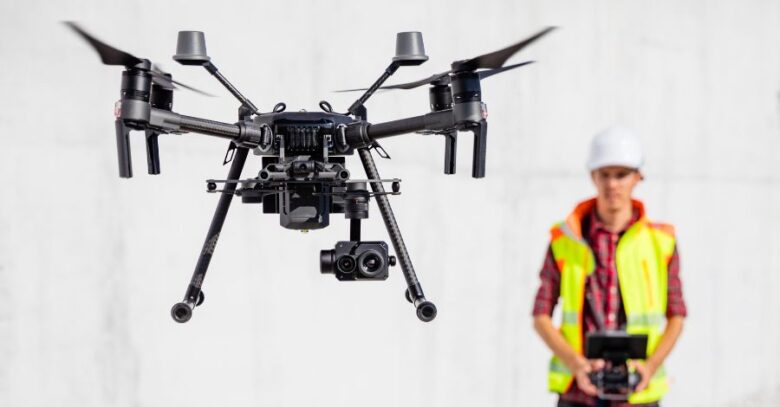Drones, or unmanned aerial vehicles (UAVs), are no longer confined to the realm of military operations or hobbyist pursuits.
They have found a place in the industrial world, offering new perspectives for process safety.
From inspection of high-risk areas to emergency response, drones are providing a safer and more efficient way to view the industrial landscape. Let’s take a closer look at how these flying machines are revolutionizing process safety.
A Bird’s Eye View of Industrial Facilities
In the realm of process safety, visibility is paramount. Drones, equipped with cutting-edge cameras and sensors, have the ability to fly over extensive industrial areas and provide an unprecedented aerial perspective. They give operators a panoramic view that’s otherwise hard to achieve with ground-based inspections, enhancing the visibility of the entire site and facilitating a more comprehensive understanding of the facility’s layout and processes.
Furthermore, drones are not just limited to providing a visual overview. Their high-definition cameras can zoom in to capture intricate details, identifying potential structural issues or maintenance needs that could contribute to safety risks. From spotting corrosion in pipelines to detecting leakages, drones are enabling us to see our industrial facilities in a new light, making them an indispensable tool in the realm of process safety.
Yet, the advantages of drones extend beyond their ability to provide a bird’s eye view. They can capture and deliver real-time images and videos, allowing for immediate analysis and swift action. This capability significantly accelerates the decision-making process and enables timely interventions, helping to mitigate safety risks before they escalate into larger issues.
Reducing Risk with Drones
The nature of industrial environments often involves dealing with hazardous substances and risky situations. Traditional methods require human presence in such areas, exposing workers to potential dangers. Drones, however, have emerged as a powerful tool in minimizing this risk. They have the ability to access areas that are dangerous or hard to reach, eliminating the need for workers to be physically present in these locations.
By replacing humans in these hazardous situations, drones significantly reduce the possibility of accidents and injuries. For instance, in situations where there is a risk of explosion or chemical leaks, drones can be used to safely assess the scene. Not only does this keep workers safe, but it also provides a more efficient and cost-effective way of conducting inspections, as drones can cover large areas quickly and without fatigue.
Moreover, the use of drones in these hazardous situations doesn’t mean a compromise on the quality of inspections. Drones come equipped with advanced sensors and cameras capable of detecting faults and anomalies that could otherwise be missed by the human eye. This ensures a thorough inspection while keeping the safety of the workers as the utmost priority.
Drones and Industrial Inspections
Routine inspections are a key aspect of process safety management. Traditional inspection methods can be time-consuming and labor-intensive, often requiring shut-downs and human entry into potentially dangerous areas. Drones offer an innovative solution to these challenges, enabling faster and safer inspections with fewer disruptions to operations.
The speed and efficiency of drones are not their only advantages. These high-tech devices are capable of capturing a vast amount of data during their flights. From thermal imaging to detailed visual inspections, drones can provide a wealth of data that is instrumental in identifying issues and planning maintenance activities. This data can be further analyzed to gain insights into the operational status of the facilities, helping to predict potential failures and optimize maintenance schedules.
Furthermore, drones offer a level of consistency that is hard to match with manual inspections. Every flight can be programmed to follow the same route and capture the same data points, ensuring that nothing is missed. In addition, the data captured is digital, which means it can be stored and referred back to over time, providing a valuable record of the facility’s condition. This level of detail and consistency contributes to more accurate and reliable inspections, reinforcing the role of drones as an essential tool in process safety.
Emergency Response and Drones
In the event of an industrial accident or emergency, the initial response is often the most crucial factor in mitigating the situation. Drones are increasingly being utilized as first responders in these scenarios due to their ability to quickly and safely reach the affected site. They provide a real-time visual assessment of the scene, allowing response teams to evaluate the situation and formulate an appropriate response plan without exposing personnel to potential dangers.
Additionally, drones can play an instrumental role in active emergency situations. Equipped with thermal cameras and gas detection sensors, they can locate hot spots in fires or detect harmful gas leaks. This information is invaluable in emergencies, helping to protect personnel, localize the problem and facilitate quicker containment of the situation.
Furthermore, drones can also serve as a tool for communication in emergency scenarios. They can deliver necessary supplies or even act as a relay for communication between teams in different areas of the site. The versatility and efficiency of drones in emergency response demonstrate their significant potential to enhance safety and effectiveness in these critical situations.
Data Collection and Analysis
One of the most valuable aspects of drone usage in process safety is the immense amount of data they can collect. From high-definition images and videos to thermal and gas readings, drones are capable of capturing detailed information about industrial facilities. This data, however, is only as useful as the analysis that follows.
The data collected by drones can be input into advanced analytic platforms, allowing for comprehensive and detailed evaluation. These insights can facilitate proactive decision-making, enabling companies to anticipate potential risks and execute preventive measures. In other words, drones not only detect existing safety issues but can also predict future ones.
In addition, the use of drones in combination with advanced technologies such as machine learning and artificial intelligence can further enhance this data analysis. These technologies can process and analyze vast amounts of drone-collected data to detect subtle changes or patterns that might be indicative of potential risks, providing another layer of predictive capabilities to enhance process safety.
Training and Regulations in Drone Operations
The operation of drones, particularly in sensitive industrial environments, requires a high level of expertise and understanding of relevant regulations. To ensure safe and effective usage, operators must undergo extensive training. This includes not only understanding how to control the drone but also how to interpret the data collected.
In addition to training, staying up-to-date with the latest regulations is crucial. Drones, being a relatively new technology, are subject to evolving regulatory landscapes. Operators must be aware of these changes to ensure that their operations are compliant, reducing legal risks and ensuring the safety of their operations.
Lastly, while the capabilities of drones are impressive, it’s essential to acknowledge their limitations. Drone operations should be part of a larger safety strategy, complementing rather than replacing traditional safety measures. Properly trained and knowledgeable operators, understanding of regulations, and an integrated approach to safety will ensure drones are a beneficial tool in the realm of process safety.
The Future of Drones in Process Safety
The potential for drone technology in the field of process safety is substantial. As we move forward, the ability of drones to conduct inspections and assessments with greater speed and precision is only expected to improve. With advancements in artificial intelligence and machine learning, the data gathered by drones will be analyzed more efficiently and accurately, leading to better risk prediction and prevention.
Additionally, drones are likely to become more specialized for various industrial tasks. This could include drones specifically designed for certain environments or situations, such as those resistant to extreme temperatures or capable of operating in low-visibility conditions. Such specialized drones would further extend the capability of these machines to enhance safety in a broader range of industrial scenarios.
Moreover, as drone technology becomes more commonplace and accepted, regulatory bodies will continue to refine their policies and guidelines to ensure safe operation. This will provide clearer guidance for operators and companies, facilitating safer and more effective use of drones in process safety.
Challenges and Considerations in Drone Use
While drones present significant benefits for process safety, their implementation is not without challenges. One of the primary concerns is ensuring that drone operators are sufficiently trained and that operations comply with the relevant regulations. Misuse or misunderstanding of drone capabilities could lead to accidents or failures that may exacerbate, rather than mitigate, safety risks.
The integration of drone data into existing safety systems is another challenge. Companies must have the necessary infrastructure to manage and analyze the vast amounts of data collected by drones. This often requires investment in new software and training for personnel, a hurdle for some organizations.
Lastly, the privacy and security implications of drone usage must be considered. Companies need to ensure they respect privacy laws when operating drones, especially near residential areas or public spaces. In terms of security, measures must be in place to protect against potential threats such as drone hacking or unauthorized use.
Conclusion
In conclusion, drones are transforming the landscape of process safety. With their ability to efficiently perform inspections and collect valuable data, they provide significant benefits for risk reduction and emergency response. However, their effective use requires appropriate training, understanding of regulations, and integration into existing safety systems.
As we look to the future, drones will continue to play a pivotal role in process safety. Their capabilities will only expand with advancements in technology, and their integration into safety strategies will become more seamless. Despite the challenges and considerations involved in drone usage, their potential to enhance process safety is undeniable, offering a sky-high view of the industrial landscape that will pave the way for improved safety measures and practices.




